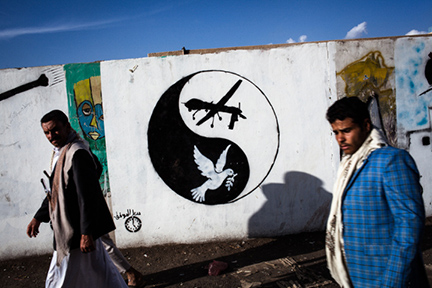
Men walk past anti-drone mural in Sanaa, Yemen, Nov. 25, 2013; photography by Juan Herrerro
Yemen’s New Ways of Protesting Drone Strikes: Graffiti and Poetry
by Tik Root, Time Magazine, November 30, 2013
An American drone hovers along a main thoroughfare in the Yemeni capital, Sana’a. Not a real drone, but rather a 7 foot-long rendition of an unmanned aircraft spray-painted near the top of a whitewashed city wall. Below it, a stenciled-on child is writing: “Why did you kill my family?†in blood-red English and Arabic script.
Painted by Yemeni artist Murad Subay, the Banksy-esque mural sits beside three others also admonishing the United States’ use of drones in Yemen to track and kill terrorism suspects. This drone art is part of Subay’s latest campaign, “12 Hoursâ€, which aims to raise awareness about twelve problems facing Yemen, including weapons proliferation, sectarianism, kidnapping and poverty. Drones are the fifth and arguably most striking “hour†yet completed.
“Graffiti in Yemen, or street art, is a new device to communicate with the people,†says Subay, 26, who after taking up street art two years ago in the wake of Yemen’s Arab Spring revolution has almost single-handedly sparked the growing Yemeni graffiti movement. “In one second, you can send a message.â€
The anti-drone chorus in Yemen has grown louder since the Obama Administration took office in 2009. All but one of the dozens of reported drone strikes in Yemen have been carried out since Obama came to office (although strikes here and in Pakistan have been more sporadic in recent months). Operations are rarely acknowledged by American officials but have nonetheless stirred a global debate about the strikes’ legality, morality and effectiveness.
Proponents argue that drones offer an efficient way of fighting al-Qaeda in the Arabian Peninsula, a Yemen-based affiliate of the global terrorist network. The Yemeni President Abd Rabbuh Mansur Hadi has endorsed the program, praising ongoing U.S.-Yemen counterterrorism cooperation and the “high precision that’s been provided by drones.†Human rights activists in Yemen and the families of many victims are outraged by the so-called “drone war†in the country, which the Bureau of Investigative Journalism estimates has resulted in between 21 and 56 civilian deaths. Aside from more conventional methods of protest – such as demonstrations, media campaigns, and the production of often scathing reports – activists are increasingly employing art as a medium through which to express their anger.
“We [have] tried to be a little bit more creative on ways [that] we can really combat the fact that drones are hovering over our cities and villages,†said Baraa Shiban, a Yemeni activist and project coordinator for the British-based organization Reprieve, which advocates for the rights of prisoners to receive a fair trial. Taking their lead from Yemen’s reputation for recitation, the group organized an anti-drone poetry contest earlier this month. The top prize: $600 or, in Reprieve’s words, “1% of the cost of a hellfire missile.â€
A panel of Yemeni poets whittled the more than 30 submissions down to six finalists and a winner. Frontrunners gathered on a recent Tuesday afternoon to share their work. One by one, contestants read their poems aloud. Some delivered their verse – containing lines such as “From above, Death descends upon us,†“Drones are the friend of our enemy†and “Do you fight terrorism with terrorism?†– more fluently than others, but the small audience of mostly friends and fellow activists greeted all of the contestants with equally boisterous applause. The winner: Drones Without Rhyme, a catchy free verse poem with a familiar theme. The winning poet, Ayman Shahari, beamed as he walked on stage.
Despite not winning, Raghda Gamal, a journalist and author of the entry Death Flying Around!, was glad that she had participated. “It’s great to use such art to send your case,†she said. “We can use a lot of tools rather than weapons.â€
Reprieve’s Shiban says that creative events like this help broaden discussions in Yemen, a country with high rates of illiteracy and limited Internet penetration. “It’s a way of engaging more sectors of society,†he says.
Subay agrees. “[Art] galleries in Yemen belong to one class. Graffiti is for all people,†he says. Two years ago there was hardly a stencil to be seen on public walls but today, thanks largely to Subay’s campaigns, they are plastered across some of the country’s most trafficked areas. Subay estimates that, in all, millions of citizens have now been exposed to street art.
Shiban is optimistic that cultural forms of protest like poetry and graffiti could be a step on the path toward ending drones strikes and affecting other changes in Yemen. Subay, however, is skeptical that art will alter policy, saying that the United States’ counterterrorism strategy will likely “carry on†regardless.
“Maybe I don’t expect any action [from the U.S.],†said Subay. “But I’ll always keep hoping.â€
Whether or not the anti-drone poetry and graffiti influences American policy in Yemen, one thing seems clear: for a region whose people have so often lived under dictators and through times of violence, peaceful protest of this sort can only be healthy.